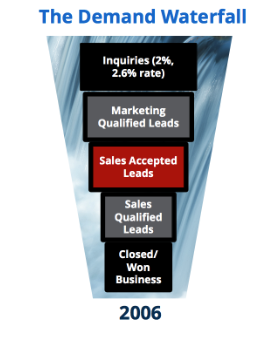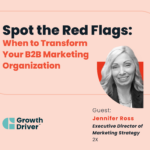This article is part of ID’s expert blog series “Old to New: How to Update Your B2B Growth Plays.” It helps GTM, marketing, and sales leaders understand, diagnose, and update their B2B growth plays by leveraging Intelligent Demand’s frameworks, resources, advice, and experience.
Let’s roll the clock back to 2006:
- “Evolution of Dance” became one of the first viral videos on YouTube
- George W. Bush was president
- Barry Bonds passed Babe Ruth’s career home run mark
And for B2B growth geeks such as us, SiriusDecisions launched its first official B2B funnel model that they called the waterfall:

What did it give us?
The funnel model (and its subsequent evolutions—see this article where we outline them) brought some good things to B2B GTM:
- Shared “revenue language” for marketing, sales, product, finance, operations, etc.
- A framework measuring and reporting the performance of B2B revenue programs and related tactics
- A framework for mapping, analyzing, and improving lead management processes
- Support for more rigorous and accurate revenue forecasts
Unfortunately, the waterfall funnel model also laid the groundwork for a lot of very unhelpful thinking and habits that we’re still trying to unlearn and move past.
Fast forward a few years…
Roll forward a few years and we entered the go-go early days when marketing automation was crossing the chasm into wider adoption of systems from Eloqua, Pardot, Marketo, and even Hubspot. Finally, B2B marketing teams had a system of record that helped them track leads and implement that waterfall funnel thing that SiriusDecisions was talking about. And it simplified B2B Marketing’s central purpose into one three-letter acronym: The Holy MQL. Marketing teams could automate, track, and deliver lots and lots of MQLs (created by sending out lots of poorly targeted email with links to gated content on landing pages) to their partners in sales—who were just dying to work all those “hot leads.”
The B2B funnel model was the kindling.
The Holy MQL was the match.
Marketing Automation was the gasoline.
What else did we need? What was missing? A buddy to fan the flames!
Then came the next transformation
In 2011, Ross & Tyler’s book “Predictable Revenue: Turn Your Business Into A Sales Machine With The $100 Million Best Practices Of Salesforce.com” came out. Much like the funnel model and marketing automation technology, this book wasn’t all bad. It brought definition and clarity to four key sales roles: Outbound SDR, Inbound, SDR, Account Executive, and Customer Success/Account Manager. It offered useful advice for how to define, hire, train, measure, and measure those roles. And it gave marketing clear direction: “Give us lots of leads that we can chase and qualify with SDRs, and then close (hunters) with account executives, and then grow (farmers) with customer success/account managers.”
Unfortunately, the thinking in “Predictable Revenue” also brought sales into cahoots with marketing around what would become a set of all-too-predictable strategies and tactics that sort of worked for a while, until they didn’t. More fuel got added to the fire with data vendors, the content marketing/inbound movement, and sales engagement platforms.
And that’s how you create The Old B2B Growth Playbook.
Let’s break that playbook down
The Good
- It gave B2B marketing and sales a process framework
- It gave us a framework for measuring marketing and sales funnel measures
- It established GTM roles for Marketing, SDR, Sales and CS (rigidly and in siloes, unfortunately)
The Bad
- It encouraged broad audience targeting of TAM and use of generic personas (no ICP)
- Marketing role = High volume leads and MQLs
- SDR role = Cold outbound
- Sales role = Sell products
- We work in silos (often, competing silos)
- No post-sale focus on LTV, NRR, renewal, expansion
- Messaging and content:
- Bottom of funnel, features, one-size-fits-all
- Gated PDFs and webinars
- Download = “Ready to Buy”
- Forms Unleash Spam
- Key Metrics:
- Downloads, leads, MQLs
- Marketing vs. sales sourced
- No single source of truth
Meanwhile, our buyers started noticing that buying was getting less, and less, and less fun.
We’ll talk about B2B buying behavior soon. But first, we need to talk about how to spot the symptoms of The Old B2B Growth Playbook.
If you need to move faster
We’ve put together everything you need into one Growth Play Success Kit (frameworks, guides, advice, tips on how and where to start, research, access to expert resources, etc). You can download it here.



